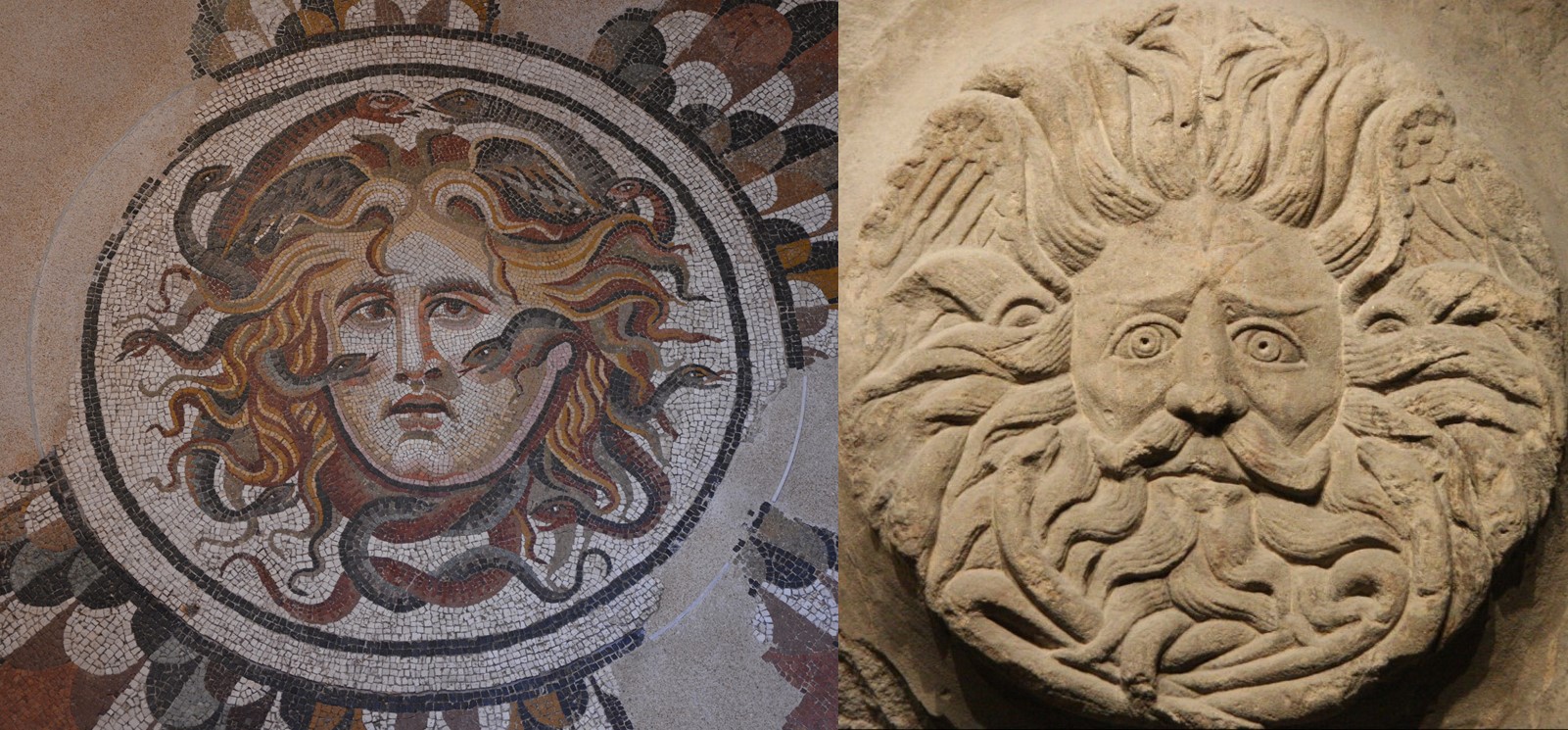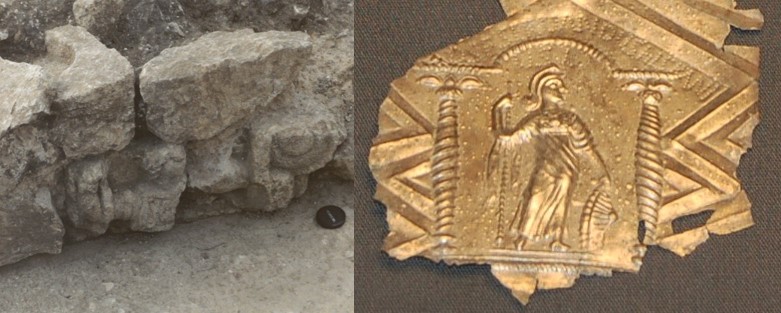Minerva and the Water God
After I wrote my article Water God, I found myself considering Roman and pre-roman gods, which turned my thinking upside-down. Whilst browsing the internet on my commute I was reminded of the Minerva head on display at the Roman Baths in Bath. I kicked myself because, when I was thinking about the Minerva at Stanwick, I didn’t make a connection between Minerva and water. It was Water God that had the connection with water, and it hadn’t crossed my mind that the separate sculptures found in the hypocaust had any relationship with each other. Now I am thinking differently.
The Roman Baths at Bath
What first caught my attention at the Baths was not Minerva but the other major find, the “Gorgon’s Head”. This is a wonderful piece of relief sculpture that was on prominent display on the pediment of the temple dedicated to Minerva within the bath complex. I smiled to myself, as it is obviously not a gorgon, the face being male. I read on. The Gorgon’s head is “the best-known object in the Roman Baths collection”. It is well documented and there is quite a bit of discussion about it online. It dawned on me, that this is not a Gorgon’s Head but something less classical and more northern European.

The Gorgon’s head
As I said, it is not a gorgon, as gorgons are female and this is a male face. At first, I presumed that the reason behind the mis-interpretation is because of the snakes entwinned within the beard and hair of this figure. A gorgon has snakes within the hair. I assume this relationship was made by the early antiquarians who first discovered the head in the 18th century. This is a perfectly understandable interpretation in the context of the antiquarian. When interpreting the unknown, we gravitate towards what we know. We fill the void with our knowledge, an instinct that is difficult to resist.
As archaeologists, there is pressure to show we are the expert by solving the mysteries and telling the public of our knowledge. But, archaeology, especially prehistory, is ambiguous. We only have a small percentage of evidence left from the total picture. The old analogy is of a jigsaw puzzle with 1000s of pieces; the further you go back in time, the less pieces you have. The challenge is to fill the gaps and when we don’t have the knowledge to do that, we come up with ideas, theories and allow ambiguity.
Unfortunately, people do not like the ambiguity and often feel let down by indecision. I’ve often met people who cannot bear it, who need to be told facts and events, and not “well it could be this, but it could be that”. The challenge of the archaeologist is to balance that need with reality. Unfortunately, in this void, myths become common place.
For the early antiquarians, although there was a beginning of understanding of pre-Roman paganism, he or she would have filled the void with a classical education. In fact, the Gorgon’s Head is uncannily similar to the Head of Medusa in a mosaic floor at the Baths of Diocletian (1st-2nd century AD, National Museum of Rome). Apart from the face it is pretty much the same.

Once labelled the “Gorgon’s Head”, the name stuck and now it’s is very much of its history. Even if the name is completely incorrect, it would not be easy to change. The Roman Baths website addresses this and points out, “Gorgons are female not male.”
At first, I thought this Gorgon’s Head was a water god, and it even suggests this on the Roman Baths website. The hair is flowing out from the face and it was located right over the famous waters of Bath. The snakes, or perhaps water serpents, are quite masculine with square fierce jaws.
Unfortunately, the figure doesn’t quite fit the description of a water god. In the background above the figures’ head are wings, exactly as in the head of Medusa. Wings are associated with flight and, the figure of the Gorgon is quite round, like the sun. I would expect a water-deity to be longer, more linear representing the flow of water, such as a river. Could the Gorgon actually be a sun-deity?
Sulis Minerva
This Minerva is not the Roman Minerva, but Sulis Minerva, who was an adapted form of Minerva. The term used is syncretism, where a pre-Roman god, ie Sulis, had been “merged” with a Roman god, this one being Minerva. The pre-Roman gods were quite localised and Sulis was a god who was very much part of the natural springs and waters at Bath. She was worshipped by the Romano-British as Sulis Minerva, evidence for which is found written in the tablets that had been deposited in the waters.

The head of Minerva in the Roman Baths, to quote the website, is “probably from the cult statue of the goddess which would have stood within her Temple beside the Sacred Spring. From there she may have looked out across the Temple courtyard to the site of the great altar, the site of sacrifice, which stood at the heart of that sacred space…” In the reconstruction on the temple complex, Minerva and the Gorgon’s Head are facing each other.
Whatever the reality of the meaning of the Gorgon’s Head, we are pretty certain that Sulis, a pre-Roman god, was connected with the springs. In my article on the Stanwick Water God, I emphasised the fundamental importance of water in everyday life. It was needed to drink, for growing crops, travel and trade. At the same time, too much water would lead to floods, crop failure and starvation. In the British Iron Age and into the Roman periods, water was a religious place, where people were depositing precious items within bodies of water. They sacrificed people and deposited them in bogs. Decapitated heads were placed in wells. Water was a sacred place and a route to the other world. In Roman Bath, Aquae Sulis, people were depositing their requests to Sulis in the waters.
Similarly, the sun and warmth were needed for crops to grow successfully. Not only was food needed for life, control of food was power and there is evidence for this control in Iron Age hillforts. If there was too much sun and no rain, then droughts would also lead to crop failure, starvation and potential loss of power. In balance, water and the sun are the basics for life. There has to be a relationship between water and sun deities. We have much evidence of worship to water deities because water will preserve organic matter. Whereas, evidence for sun worship has disappeared after 2000 years. I would not expect such evidence to be preserved so well. Perhaps the Gorgon’s Head, facing Minerva across the temple courtyard, was a sun deity, a syncretism with Medusa.
Senuna
Another syncretism with Minerva and an association with water, was found in a village called Ashwell, which is only about 30 miles from Stanwick. In 2002 a metal detectorist found over 20 votive offerings dedicated to Senuna. These were deposited by people, asking favours of Senuna on a site that was more than likely to be religious. The imagery in these offerings shows evidence of syncretism between a pre-Roman goddess with Minerva. Again, Senuna, like Sulis, was probably localised to the area. To the south-east of the village is an Iron Age hillfort, so the area has strong links with a pre-Roman population. There could be a continuity of Senuna stretching back into the Iron Age.

The village itself has strong connections to water, an obvious clue being in the name, Ashwell. It is the perennial source of the River Cam and there are numerous springs in the area. A few years after the finds were discovered, an excavation took place of that area. The site was one of water sources, “… and at the heart of the site was a ceremonial hollow which appears to have its origin as a spring.” (Jackson and Burleigh).
In the archaeological report Ralph Jackson and Gilbert Burleigh conclude that there are similarities between Senuna and Minerva, even if there is no direct evidence for a “…formal conflation of the two deities”. But also,
“… the figurine dedicated to Senuna has similarities also the imagery of the goddess Fortuna. Both water and fertility were perhaps central to the cult of Senuna.”
The Stanwick and Ashwell Minervas
There is strong similarity between these images of Senuna and the Stanwick Minerva. The plaques from Ashwell are variable, but essentially show the classical images of Minerva, with spear, shield and owl. The relief sculpture from Stanwick shows a fragment of an image, with the Minerva facing to her left, with her right forearm curling around a spear and part of a column on her left. I have put a similar Ashwell image next to this for comparison.

Other Minervas
The more I look the more traces of Minerva and water I see. One example is on the outskirts of Harlow. Here are the remains of a Roman Temple, dedicated to Minerva, or so it is thought. It was not far from a small Roman settlement and the hill it is on has a continuity back to at least the Bronze Age and the area has strong Neolithic connections. The site is on a hill, which overlooks has waterways running directly below.
Another more recent, possible connection with Minerva and a Water God is within the north east corner of the bank of England. Soane, in his design for the Bank, put in a “temple” based on the one in Tivoli. There is little decoration, except for two owls (associated with Athena and Minerva) and a water god. The Bank of England is located right over the River Walbrook which during the Roman period and before was a river valley, with Ludgate Hill on onside and Cornhill on the East.

I have also come across the Franke Minerva 3 in 1 Hot Water Tank. Why would Franke call a hot water tank and tap “the Minerva”?

What do we have?
We have connections between Minerva, a previous pre-Roman deity which Minera was adapted from, a relationship with water, the sun and a male water god. The importance of water cannot be over-stated. Not only are there the logical life surviving aspects of water, there is plenty of archaeological evidence form the pre-Roman Iron Age that shows the ritual significance of water. The very need for life is water, but also needed is a balance with the sun.
Over the past 30 years since excavating the fragment of the Stanwick Minerva in the summer of 1990, I had never thought that there could be a relationship between the Minerva and Water-God we uncovered. Had this Minerva been a syncretism with a previous local pre-Roman goddess; a goddess that related to the people of Stanwick in the Iron Age and beyond that? I now think so. Before I presumed there was a temple that was dedicated to Minerva, with a number of other relief sculptures relating to the owner, the family and the stories they wanted to tell. Within the past 3 months, I have completely changed my mind. I believe there was a direct relationship between the two representing water and a relationship with sun.
Which god are we looking at? Religions adapt, new religions come along and adopt the previous customs, local quirks and gods. In this case, are we looking at Roman Gods, or are the actual the pre-Roman gods? Is it right to use the term Minerva? By using this term, we may well be mis-informing ourselves and leading ourselves down the wrong paths, as the 18th century antiquarians did with the Gorgan’s Head.
Perhaps there are more Minervas linked to water that we don’t know about. We still have yet to join the dots. I am of the belief “where there’s smoke, there’s fire”. Think of that jigsaw puzzle. You have part of a picture and you are pretty sure what it is going to be, you just don’t have the pieces. Such a theory, within time, may be turned on its head. This is the beauty of ambiguity. We can adapt, change our point of view and the stories as more evidence comes to light.
References
Websites
The Roman Baths, Bath – https://www.romanbaths.co.uk/key-objects-collection
The Report on Ashwell, British Museum – https://www.britishmuseum.org/research/research_projects/all_current_projects/ashwell_roman_treasure.aspx
Ashwell Museum – http://www.ashwellmuseum.org.uk/page_id__21_path__0p4p.aspx
Publications
Ashwell Senuna: Treasure, Cult and Ritual at Ashwell, Hertfordshire. Jackson, Ralph and Burleigh, Gilbert. 2018. The British Museum.
FRANKE MINERVA 3-IN-1 HOT WATER TAP: HEATING TANK INSTALLATION GUIDE,
Images
The Hoard from Ashwell – By Portable Antiquities Scheme from London, England – Baldock Hoard Uploaded by Victuallers, CC BY 2.0. Photo by Dominic Coyne, Young Graduates for Museums and Galleries programme August 2007. https://commons.wikimedia.org/w/index.php?curid=10720091
Gorgon’s Head – Joyofmuseums, CC BY-SA 4.0, https://creativecommons.org/licenses/by-sa/4.0
Minerva – By Hchc2009 – Own work, CC BY-SA 4.0, https://commons.wikimedia.org/w/index.php?curid=50332923
One other thing
On the discovery of the plaques uncovered in Ashwell, A Pagan group in the US wanted to connect with Senuna:
“We began by studying the available articles about Senua, and photographs of her artifacts. We also studied (to the best of our ability, from 3,000 miles away) the landscape in which she was found, and what is known of the land’s use and inhabitants during the Celto-Roman period.
When we reached the limits of known facts, we entered the realm of religion and worship. Within Paganism, meditation is a known and accepted way of forming connections with the Divine.” http://www.janeraeburn.com/senua/index.html
That is one way of working with archaeological ambiguity.
© The Historier 2019

It is the prototype for the green man face? Fascinating post.
LikeLike
That’s a really interesting connection. The Green Man could well be the remnants of a pagan God or the Iron Age head cult. I always look out for them in churches. I even have one on my desk looking at me as I write.
LikeLiked by 1 person
Me too! Your post was so well researched and original I have been waiting for another!
LikeLike
Thank you. I appreciate you saying. I have another one almost ready, but being a parent makes me very slow at writing anything.
LikeLike